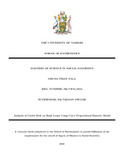| dc.description.abstract | Credit business is the leading income generating activity for banks and other financial institutions. However, it involves huge risks to both the banks and the borrowers. The risk of a trading partner not fullling his or her obligation as per the agreement on due date or any time before the due date can greatly jeopardize the smooth functioning of a financial institution. All credit scoring models contain similar fundamental concepts. Lately, survival analy-sis has been used to give time angle to the event of interest. It is the area of statistical applications that deals with the analysis of lifetime data. The variable of interest is the time to the occurrence of the event of interest. It is ordinarily utilized in medical studies to test the impact of a drug in the lifetime of a patient and in engineering to study reliability aspects of a certain machine.The advantage with survival analysis is that the model is capable of including censored and truncated data in the development sample. The most common form is right censoring which states that the event is not observed within the study period e.g a customer who does not default. Credit risk is one of the greatest concerns to most lending institutions. This paper is aimed at coming up with a model that can be used by the banks and other credit advancing institutions to calculate the risk associated with credit advancement. Cox's proportional hazards modelling is applied in the generation of this model since its the most suitable for survival data when proportional hazards has been proved in various groups. Since the paper is interested in customers who default on their loans when they are due, those who pay in time and those who have paid in advance are censored to isolate them from analysis of those who receive events of interest. The Cox's PH model has been preferred due to its flexibility and robustness in deter-mining hazard risks. It is different from the normal PH model because no assumptions
are made on its baseline hazard function . This is the non-parametric part of the model. It however makes assumptions on its parametric part, the part containing the effect of the predictor variables on the hazard. The model is therefore semi-parametric as it contains both non-parametric part and the parametric part and it estimates the relative risk rather than the absolute risk. It is also capable of handling discrete and continuous measures of event times and its possible to incorporate time-dependent co-variates over the course of the observation period.Credit scoring models calculate a persons credit score primarily from information con- tained in his application form including age, time with bank (months), gender, employer details, county of birth, basic salary, credit history (number of loans taken with the bank), type of employment (contract, permanent, casual), amount, repayment period time, time at current job (months), marriage status and purpose of loan. The per-sons payment history erects the various accounts that he has, including credit cards, mortgage advances and deposit accounts. Collections, foreclosures and lawsuits are categorized as factors and given a weight (Credit Risk Scoring Analytics, Issue No:0710511).Using survival analysis procedures for building credit hazard models is not new. It started with the paper by Narain (1992) and was then developed by Carling et al. (1998), Stepanova (2002), Roszbach (2003), Glennon (2005), Allen (2006), Goko (2006), Malik (2006) and Djadja (2007). A typical feature in all these papers is that they utilize parametric or semiparametric regression strategies for analysing the time to default, such as exponential, Weibull and Cox's proportional hazards models, which are ma-jorly used in this kind of study. The model established for the time to default is then used to analyze Probability to Default (PD). This paper proposes a basic idea to estimate PD, which is performed using the Cox's proportional hazards model. Some random right censoring mechanisms appear in the model and so survival analysis techniques become natural tools for use. The conditional survival function utilized to model credit risk opens a remarkable per- spective to studying loan defaults. Instead of looking at whether loan defaults or not, the paper looks at the time to default, given credit information of clients (endogenous variables) and considering the indicators for the economic status (exogenous variables). Therefore, the default risk is measured using the conditional distribution of the random variable time to default, T, given a vector of covariates, X. | en_US |



